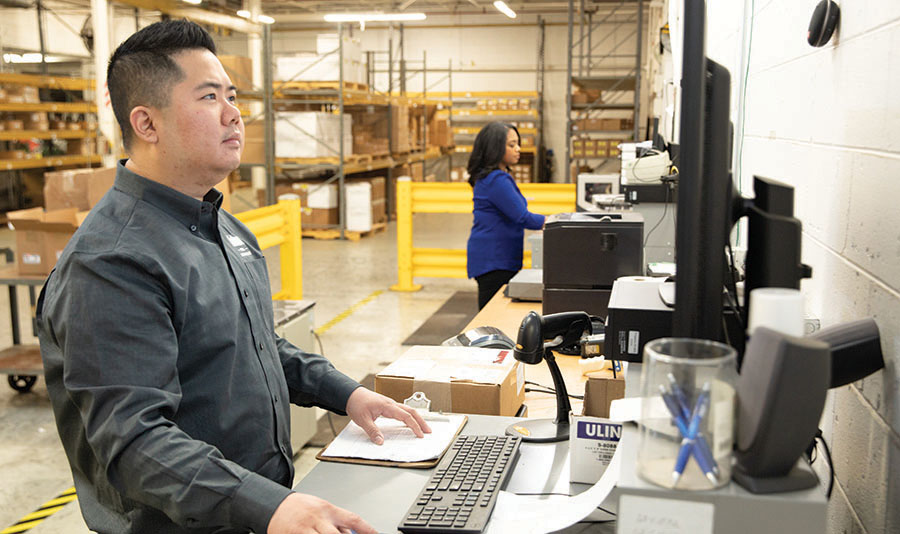The Democratization of TMS
Once reserved for large companies with deep pockets, transportation management systems (TMS) are now accessible to a wide range of shippers across all industries
Logistics challenges continue to shape the supply chain, where transportation is a costly and time-consuming component. And while 2019 saw an easing of the trucking capacity crunch, issues like the persistent driver shortage, global tariff uncertainty, and the ongoing need to digitize operations are all pushing shippers to rethink their transportation management approaches.
Transportation management systems (TMS) are helping about 26% of companies solve those challenges, according to Peerless Research Group’s “2019 Technology Study.” Software that helps shippers select the best carriers, track freight while it’s on the road, and make routing decisions, TMS helps to streamline and simplify the movement of freight.
“TMS continues to play a larger role in supply chain execution [SCE] software,” says Bart De Muynck, Gartner’s research vice president, transportation technology. Distributed order management (DOM), warehouse management systems (WMS), and global trade management (GTM) also fall under the SCE umbrella. Of those four platforms, WMS has the highest adoption rate at 39%, De Muynck says, followed by TMS at 29% according Gartner’s research. That 10% gap (between WMS and TMS) is closing and is expected to be less than 4% by 2022.
“By 2022, we expect WMS to be 35% of the SCE market and TMS to be around 31.5%,” says De Muynck. “Where WMS has always been kind of the ‘big brother’ in terms of its share of the market, we’re beginning to see TMS become almost as big as WMS within the SCE market.”
This is a significant point, and one that’s being driven in part by Cloud adoption. One of the first supply chain software platforms to go into the Cloud, TMS vendors naturally stood to benefit when this deployment model started gaining traction. This, in turn, made TMS more accessible for a wider swath of companies. “We’ve definitely seen the democratization of TMS,” says De Muynck, who remembers a time when TMS was mainly used by large companies that had deep pockets and in-house IT resources.
Fast-forward to 2020 and the walls preventing small- to mid-sized companies from realizing the benefits of TMS no longer exist. “We’ve gotten to a point where it really doesn’t matter what industry you’re in, what region you’re in, or whether you spend $100,000 on freight or $100 million on freight. TMS is within your reach,” says De Muynck. “We have the Cloud to thank for that because it’s made the applications a lot cheaper and more user-friendly.”

In 2016, Holman Parts selected a cloud-based TMS that it’s now using across all of its distribution centers.
Smaller players step up
A software segment that was once dominated by larger vendors like SAP, JDA, and Oracle, TMS has become a hotbed for innovation by smaller, Cloud-based providers that have opened their platforms up to a larger group of shippers.
“In the last 18 months, we’ve seen some smaller players making a significant push toward some of our customers, and those users are quite happy with these [platforms],” says Ramond Coleman, senior manager, digital supply chain practice at technology consulting firm CapGemini.
“Some of the players we don’t even see on the [Gartner] Magic Quadrant, which is surprising to us,” Coleman continues. “However, their TMS capabilities are pretty comprehensive—to the point where some of these smaller players could take over some of the market share that larger TMS providers held in the past.”
Like De Muynck, Coleman says the Cloud is pushing both sides of the equation. It’s making TMS more accessible to more shippers while also creating a “sandbox” of sorts for technology vendors looking to develop Cloud-based supply chain systems. In most cases, those solutions are more affordable than earlier, on-premise options. This makes TMS more attractive to shippers that have been reluctant to surrender their manual, paper-, and phone call-based transportation management approaches.
Coleman is also seeing more predictive analytics embedded in TMS versus just being “bolted onto” an existing solution. “They’re getting creative and making an all-in-one solution,” he explains. “A lot of companies don’t like the idea of implementing TMS and then having to add additional services at a later date. The vendors that are embedding analytics and other capabilities are differentiating themselves from some of the other options on the market.”
Holman Parts: From old school to streamlined processes
To manage its national transportation network, Holman Parts Distribution based in Pennsauken, N.J., has always relied on a combination of websites, carriers, phone calls, faxes and e-mails. “It was pretty old school,” says John Conte, director of logistics operations. “There was no technology in play.”
The tipping point came in 2014, when this national provider of powertrain solutions exited some unprofitable markets, switched up its customer base, and realigned its product offerings. The company has 10 DCs nationwide that ship to automotive customers like Ford, General Motors, Chrysler and Mercedes-Benz.
“We decided to focus the distribution of OEM product using national fleets and dealerships,” says Conte, whose team began looking more closely at where the company was shipping to—and perhaps more importantly, how it was shipping those goods.
“We quickly realized that we didn’t know how much we were spending on transportation,” says Richard Scott, a logistics analyst at the parts distributor. More specifically, the company had little visibility into whether the actual invoiced amounts matched what it was expecting to pay on the front end. It also wanted customers to be able to track their orders on a self-serve basis—something it wasn’t offering at the time.
“As part of our new overall corporate strategy,” says Conte, “we knew that we needed to put a better focus around logistics and invest in some technology.”
Tasked with finding that technology, Conte wanted a system that would integrate with the company’s existing enterprise resource planning (ERP) system, that would be able to scale up as the company grew, and could manage electronic freight rate audits on the same platform. “With those basic requirements and a Google search,” says Conte, “we came up with a list of potential TMS providers.”
In 2016, Holman Parts selected the Kuebix TMS, which it’s now using across all of its DCs. The software provides invoice auditing, vendor management tools, and to is being used to strategically plan large-scale changes (i.e., new distribution centers). According to Conte, the company uses the TMS as an “all-in” logistics and supply chain tool.
“Because all shipments go through a single system—be it parcel or freight—customer support no longer has to jump on four or five different websites to get the tracking information,” says Conte. The system also “pushes out” that tracking information and allows customers to track their shipments online.
Holman Parts has also used its TMS to significantly reduce its overall transportation spend—to the tune of about $400,000 within 12 months of implementing the new platform. “It was basically a $15,000 investment at the time,” says Chelsea Short, logistics coordinator. “Once we saw that cost reduction, we knew we could be doing even more with the system.” When the company integrated the TMS with its ERP, for example, new operational efficiencies soon followed.
Instead of employees having to key information in by hand, for example, they just type in sales order numbers and let the ERP create the sales order flow and bill of lading. The system is currently being rolled out company-wide across eight operating units, which includes roughly 60 different locations.
To shippers that are taking their own manual transportation management systems into the digital age, Conte says change management has been the most difficult part of the transition. “We had warehouse employees who had been here for 40 years to 50 years, doing things the same way every day,” he explains. “For them, implementing new technology and processes can be scary.”
To work through these obstacles, Conte says Holman Parts opened up the lines of communication with those employees, asked them for their feedback, and kept them up to speed with the changes. “We held monthly ‘update’ meetings where we let everyone know what we were doing, what TMS companies we were considering, and what our goals were. It was just constant reinforcement and keeping everyone involved in the process.”
A market resurgence
With TMS opening up to a broader audience, and with vendors coming up with innovative new capabilities and integrations, this particular software sector’s growth trajectory should continue in 2020 and beyond. Also driving that train are a host of transportation challenges that aren’t getting any easier to manage using manual systems.
Going forward, Gartner’s De Muynck says he expects even more evolution in the TMS space, where more end-customers expect end-to-end supply chain visibility and where more companies are partnering to ensure those expectations are met.
“Some of the newer solutions on the market are creating a lot of positive momentum around TMS right now,” says De Muynck. “This is the kind of resurgence that we don’t usually see with well-established software solutions, but it’s definitely happening.”

Article Topics
TMS News & Resources
First scheduling API through the Scheduling Standards Consortium is released by Uber Freight TD Cowen/AFS Freight Index points to a muted peak season and mixed activity across TL, LTL, and parcel markets Enterprise Resource Planning (ERP) continues to push further into Supply Chain Management (SCM) Gain Greater Visibility With ERP & TMS Integration Top Transportation Management System (TMS) Trends for 2023 Trimble acquires Transporean in major deal, for nearly $2 billion What you need to know for a better ROI More TMSLatest in Logistics
Warehouse/DC Automation & Technology: Time to gain a competitive advantage The Ultimate WMS Checklist: Find the Perfect Fit Under-21 driver pilot program a bust with fleets as FMCSA seeks changes Diesel back over $4 a gallon; Mideast tensions, other worries cited Four U.S. railroads file challenges against FRA’s two-person crew mandate, says report XPO opens up three new services acquired through auction of Yellow’s properties and assets FTR’s Trucking Conditions Index weakens, due to fuel price gains More LogisticsAbout the Author
Subscribe to Logistics Management Magazine

Find out what the world's most innovative companies are doing to improve productivity in their plants and distribution centers.
Start your FREE subscription today.
April 2023 Logistics Management

Latest Resources
















